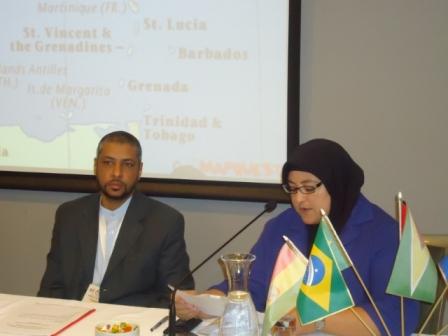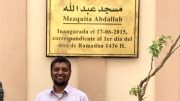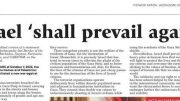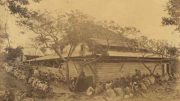This is the text of a presentation made to the 2nd International Congress “Worlds Meeting” – The Islamic and Arabian Cultural Influence in Latin America and the Caribbean held from 12th to 14th November 2012, Santiago, Chile, by Barbados delegate Suleiman Bulbulia.
INTRODUCTION
The Caribbean chain of islands form a 2400 km archipelago, the Antilles, stretching from Cuba in the north to Trinidad in the south. The Antilles and neighboring Bahamas comprise the West Indies.
The countries in this geographical region
The countries in this geographical region are as follows. Included in this list are Guyana, French Guiana and Suriname in South America, Belize in Central America and Bermuda in the north Atlantic. These countries have traditionally been associated with the Caribbean region due to language, historical considerations and similar cultural and ethnic makeup.
| ENGLISH –CARIBBEAN | FRENCH – CARIBBEAN |
| Anguilla | French Guiana |
| Antigua & Barbuda | Guadeloupe |
| Bahamas | Haiti |
| Barbados | Martinique |
| Belize | |
| Bermuda | |
| British Virgin Islands – Tortola | |
| Cayman Islands | |
| Dominica | |
| Grenada | |
| Guyana | |
| Jamaica | |
| Montserrat | |
| St. Kitts & Nevis | |
| Nevis | |
| St. Lucia | |
| St. Vincent | |
| Trinidad & Tobago | |
| Turks & Caicos Islands | |
| US Virgin Islands – St. Croix, St. Thomas | |
| DUTCH – CARIBBEAN | SPANISH – CARIBBEAN |
| Aruba | Cuba |
| Bonaire | Dominican Republic |
| Curacao | Puerto Rico |
| St. Maarten | |
| Suriname |
CARIBBEAN MUSLIM COMMUNITIES
The total population in this region is around 43 million while the Muslim population is approximately ½ million. There are about 400 mosques.
The Muslim communities in the Caribbean comprise Muslim individuals and families, Mosque-based associations called jamaats, Islamic associations registered as incorporated bodies, companies, charities, co-operatives and friendly societies together with unregistered ones, national umbrella groups and representatives of international Islamic institutions.
The Muslim communities in this region can be divided into three broad categories, ‘matured’, ‘maturing’ and ‘new’. The communities in Suriname, Guyana, Trinidad, Barbados, Jamaica, Puerto Rico, and Belize can be considered among the matured communities, while the communities in the remaining territories will fit into the other two categories.
The ‘matured’ communities can be considered such as the uninterrupted presence of Muslims there can be traced for over 100 years and these communities have developed several necessary Islamic institutions vital for the survival and maintenance of the Muslim community. These institutions include mosques, schools, cemeteries, economic and financial entities and social welfare institutions.
The ‘maturing’ communities will have mosques but have not fully developed the other institutions of importance. The ‘new’ communities are now striving to establish mosques and include many of the smaller islands in the Caribbean who despite their small land and population size do still have small pockets of Muslims. These Muslims are either expatriate or immigrant workers or persons who may have live abroad, accepted Islam and then returned to the island to live.
Muslim communities have traditionally developed on their own in their respective countries with some interaction with Islamic organizations from within and outside the region.
HISTORY
To most of the literate world today, the first contact the Caribbean region had with the outside world was on October 11, 1492 when Christopher Columbus landed on the island of San Salvador. Very little mention is made about the presence of Muslims till the nineteenth century with the arrival of indentured laborers from India. In reality, the history of Islam and Muslim peoples in the Caribbean stretches back over one thousand years, predating European contact by over six centuries.
Several noted historians have written on the presence of Africans in the Caribbean region and the Americas many years before Columbus set foot on the shores of the Caribbean. The renowned American historian and linguist, Leo Weiner of Harvard University in 1920 wrote a controversial but well documented work entitled “Africa and the Discovery of America”.
He proved in it that Columbus was aware of the Mandinka presence and that the West African Muslims had not only spread throughout the Caribbean, Central and South America, but they reached Canada and were trading and intermarrying with the Iroquois and Algonquin Indian nations.
Dr. Abdullah Hakim Quick in his book “Deeper Roots” points out: “Evidence leading to the presence of Muslims in the ancient Americas comes from a number of sculptures, oral traditions eye-witness reports, artifacts and inscriptions.”
Historians and authors, Ivan Van Sertima, “They came before Columbus” and Cyrus Gordon “Before Columbus” has also written on Africans and Muslims in the regions before the Europeans.
With the arrival of the Christopher Columbus came another wave of Muslims to the Caribbean and the Americas. In fact several historians have credited Muslims for Columbus’s success in reaching the “New World”. Columbus and early Spanish and Portuguese explorers were able to voyage across the Atlantic (a distance of 24,000 Kilometers) thanks to Muslim geographical and navigational information, in particular maps made by Muslim traders, including Al-Masudi (871 – 957 CE) in his book ‘Akhbar Az-Zaman’ (History of The World) which is based on material gathered in Africa and Asia.
It has also been reported that Columbus had two captains of Muslim origin during his first transatlantic voyage Martin Alonso Pinzon (Pinta) and Vicente Yanex Pinzon (Nina). The Pinzon family was related to Abuzayan Muhammad III (1362 – 66 CE), the Moroccan sultan of the Marinid dynasty (1196 – 1465 CE). Additionally “Moorish” prisoners were sent on the ships of these European explorers to do the manual labor.
When European domination of the Caribbean region and the Americas was established most of the first nation, indigenous people in the islands of Caribbean were wiped out. The demand was increasing for a cheap form of labor to work the growing fields of sugar, corn and other food crops. The Europeans turned to Africa and brought in by ship across the Atlantic thousands of African slaves.
This importation of African slaves represented another wave of Islam and Muslims to the Caribbean region. An estimated one-fifth of the slaves bought to the Americas were Muslims. Tribes of Mandingo, Fulani and Hausa – among other nations were Muslims bought from West and Central Africa. Historians have reported evidence of these slaves knowledge of reading and speaking Arabic and attempts to practice their Islamic beliefs.
It has also been noted that there was a strong tradition of resistance from Muslim slaves. Slave revolts in Jamaica, Haiti, Trinidad and Guyana have been credited in many instances to Muslim slaves. The ‘maroons’ in Jamaica who until today have their own settlements have found to have many traits and practices linking them back to their Muslim ancestors among the slaves who fought for freedom from slavery. In Trinidad African Muslims formed a ‘Mandingo Society’ and established schools in Port of Spain in the 19th Century. They were led by one Yunus Muhammad Baath. One of the group’s concerns was to raise money to buy the freedom of Muslim slaves. This group petitioned the British government and began with the Arabic phrase ‘Allahumma Salle Alaa Muhammad’. The British refused.
Regrettably this period of Islam and Muslims in the Caribbean did not leave a lasting and tangible influence on the Caribbean because of the immense opposition to any culture, religion and way of life other than that of the European masters of the time.
With the abolition of slavery and the emancipation of the slaves in the mid 19th Century the system of indenture labor replaced slavery for a source of cheap labor. The Europeans used this system to contract manual labor from the Indian and Asian sub-continent to work on the plantations in the Caribbean. Between 1838 and 1924 nearly half a million Indians entered the region. One in six was Muslims. These indenture servants as they were called primarily went to Trinidad, Guyana, Jamaica and some smaller islands. While the Dutch brought Muslims workers from Java, Indonesia to Suriname.
It was from among these indenture servants and the subsequent migration to various islands in the Caribbean of economic migrants from India, Asia and the Middle East seeking a better standard of living that Islam and Muslims became a lasting presence and influence in the Caribbean.
THE ISLAMIC CULTURAL INFLUENCE
The indenture servants and the economic migrants brought with them their religious beliefs, cultural practices and way of life to their new homes. The pressure was not as great on them to give up these practices as it was on the early generation of Muslims who were slaves living at the command of their slave masters. However there still existed some strong influence on them to abide by the existing cultural and social practices dictated by the European colonial authorities.
In that atmosphere and in generally very poor conditions for both the indenture servant and economic migrant Muslims managed not only to maintain their religious identity but to also establish the foundation of Islamic principles and institutions that were easily built upon by later generations.
Muslims in the various Caribbean islands and countries that they came to, namely Trinidad, Guyana, Suriname, Jamaica and Barbados were able to establish masajid/mosques soon after their arrival. The establishment of a place of worship meant Muslims had a place to congregate and conduct their affairs collectively and so not be on their own in an otherwise hostile environment. The communities that sprung up around each mosque or vice versa in some cases meant the establishment of an Islamic presence in the society.
This presence was maintained, it was argued, by the several different activities conducted by these early Muslims. The congregational prayers, especially Jumma on Fridays, the gatherings to break fast in Ramadan, the gatherings on Eid ul Fitr and Eid ul Adha, the getting together at weddings and funerals, and in Trinidad and Guyana the practice of gathering to sing praises to the Prophet Muhammad. These activities in total helped in allowing these early Muslims to maintain their Islamic identity and beliefs.
In addition to these activities allowing Muslims to maintain their beliefs and religious practices, their food, dress, languages and other cultural practices were also preserved.
As the indenture system came to end in the early 20th Century most of those in the system stayed on and never returned to their country of origin. They became very much part of the society in the Caribbean.
This act of remaining in the country meant the consolidation of the Islamic presence and preservation of the Islamic and Muslim identity and culture on the region.
Today over 100 mosques are part and parcel of the landscape on the island of Trinidad. Many in the architecture similar to mosques found on the Indian and Asian sub-continent. The story is the same in Guyana and Suriname.
The food brought by the early Muslims from India are incorporated in the cuisine of these countries with roti, curry and other Indian dishes all consider part of the national diet. “Halal meat and chicken” are very common in Trinidad, Guyana and Suriname with famous international fast-food chains in these countries offering halal menus. This practice is now catching on in Barbados and other islands of the region.
Dress, music and cultural practices have also made similar impact on the wider society and today form an important part of the national identity of the State.
The early Shia Muslims in Trinidad left a practice which is still a festival there. The festival of Hosay, commemorating Ashura. While the majority main stream sunni Muslims do not identify with this festival and its practices several Trinidadians and Government institutions still promote the festival as part of its cultural heritage during the Islamic month of Muharram. Bands of people carrying brightly colored “Tadjahs” replicas of the tombs of the grandsons of the Prophet Muhammad take to the streets in parts of Trinidad to celebrate the occasion.
Suriname today boasts the largest percentage of Muslims in the Western hemisphere with just under 25% of its population having Islam as their faith. Trinidad and Guyana each have just about 10% of their population as Muslims while all the other countries/islands in the region have around 1% of their respective populations.
Despite these small numbers Muslims have had some influence in these countries and significant achievements not witnessed in many parts of the western world. Since gaining independence in the mid 20th century Trinidad, Guyana and Suriname have all recognized as national public holidays, Islamic festivals. In Trinidad, Eid-ul-Fitr is a national public holiday each year. In Guyana, Eid-ul-Adha and the birthday of the Prophet Muhammad, are national public holidays and in Suriname both Eids are national public holidays. No other countries in the Western hemisphere have achieved this milestone.
The significance of these national public holidays means that the wider population can understand and appreciate the importance of Islamic beliefs and practices and share in the cultural expressions of Muslims at these important moments on their calendar.
The part played by Muslims in politics, economic activity, education and other strategic activities in their respective countries have all helped to bring about a level of influence for the positive reinforcement of Islamic culture in the wider society.
The highest office of Government, President, was achieved by a Muslim in Trinidad and Tobago some years ago. It was reported that during his tenure all alcoholic beverages were prohibited at his official functions. Muslims over the years have and continue to hold positions of Ministers, Senators and other important governmental portfolios in several Caribbean territories.
In the field of business several Muslims have managed successfully to established small, medium and large scale business enterprises in a wide variety of sectors contributing in a very meaningful way to the development of the society. These economic activities have helped in creating employment, increasing the income of many and adding to the economic fortunes of the society as a whole. A Trinidadian Muslim businessman whose soft drink enterprise started out in Trinidad now has plants in other parts of the world including Saudi Arabia. In Barbados a unique enterprise of itinerant trading evolved from the early Muslims and developed to the modern day form of credit purchases. Many prominent Barbadians today, leaders and others all champion the role of the Muslim itinerant trader who sold goods primarily to the poor in society on credits terms that allowed them to pay off over a time period suitable to their budget with just a handshake and goodwill.
In education Muslims have managed to set up and maintain schools, both at the primary and secondary level to cater not only to Muslims but students of all backgrounds. These schools have over the years done exceptionally well achieving above the average of most schools in the country while being a source of positive Islamic cultural influence.
In recent years several governments in the Caribbean region have expanded their relationships beyond their traditional partner countries in North America and Europe and have actively pursued and set up diplomatic relations with Muslim countries. In some cases local Muslim communities or individuals have been engaged to work alongside Ministers of Government in pursuance of this objective of engaging with Muslim countries. The former Guyanese President, Bharat Jagdeo, took with him on a tour of several Muslim nations a few years ago, the President of the Central Islamic Organization of Guyana, Fazeel Ferouz.
Suriname and Guyana are full members of the Organization of Islamic Conference. While both countries benefitted from grants of the Islamic Development Bank. Caribbean governments especially at this time of a worldwide recession are very aware of establishing and maintaining ties with the oil-rich Muslim states in the Middle East. This engagement has provided opportunities for Caribbean people to have access to Arab and Islamic culture through the grant of scholarships and other avenues to study and visit the Middle East.
As Caribbean countries generally rely heavily on tourism, engagement with these countries opens new markets for tourists to come from. The Caribbean has experienced over recent years the increase in tourists from Arab and Muslim countries. Hotels have found the need to modify and cater to these ‘new’ tourists. Engaging local Muslim communities in an attempt to understand the needs of these Muslim tourists have become an established practice in the tourism sector.
CONCLUSION
The Islamic Cultural Influence has developed strongly and been maintained in some Caribbean countries, especially those with a ‘matured” Muslim community. In the ‘maturing’ and ‘new’ communities that cultural influence is a work in progress, with perhaps many years more before it reaches the same level as that of Trinidad, Guyana and Suriname.
The lessons of these countries must be studied so that experiences can be learnt from and mistakes avoided.
Caribbean people generally have an appreciation for Islam and Muslims but their attitude to Muslims can at times be shaped and informed by worldwide events which are usually reported by the Western media and which more often than not present a distorted view of Islam.
Caribbean Muslims through their beliefs, practices, cultural expressions and history in the region have an important role to play in presenting the true picture of Islam to the wider society.
The engaging by Caribbean governments of Muslim nations can also be an important opportunity for local Muslim communities to benefit and for the Islamic culture to be an influence in the region.





Be the first to comment on "THE ISLAMIC CULTURAL INFLUENCE IN THE CARIBBEAN"